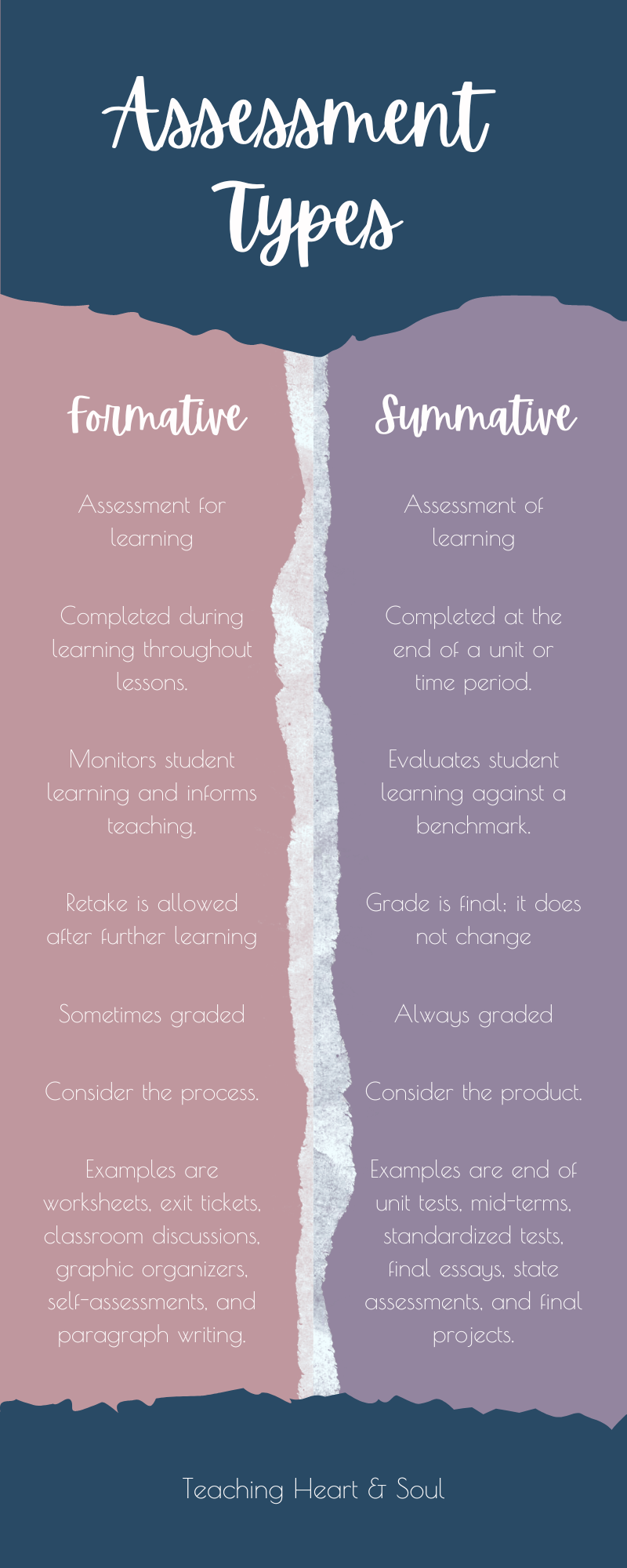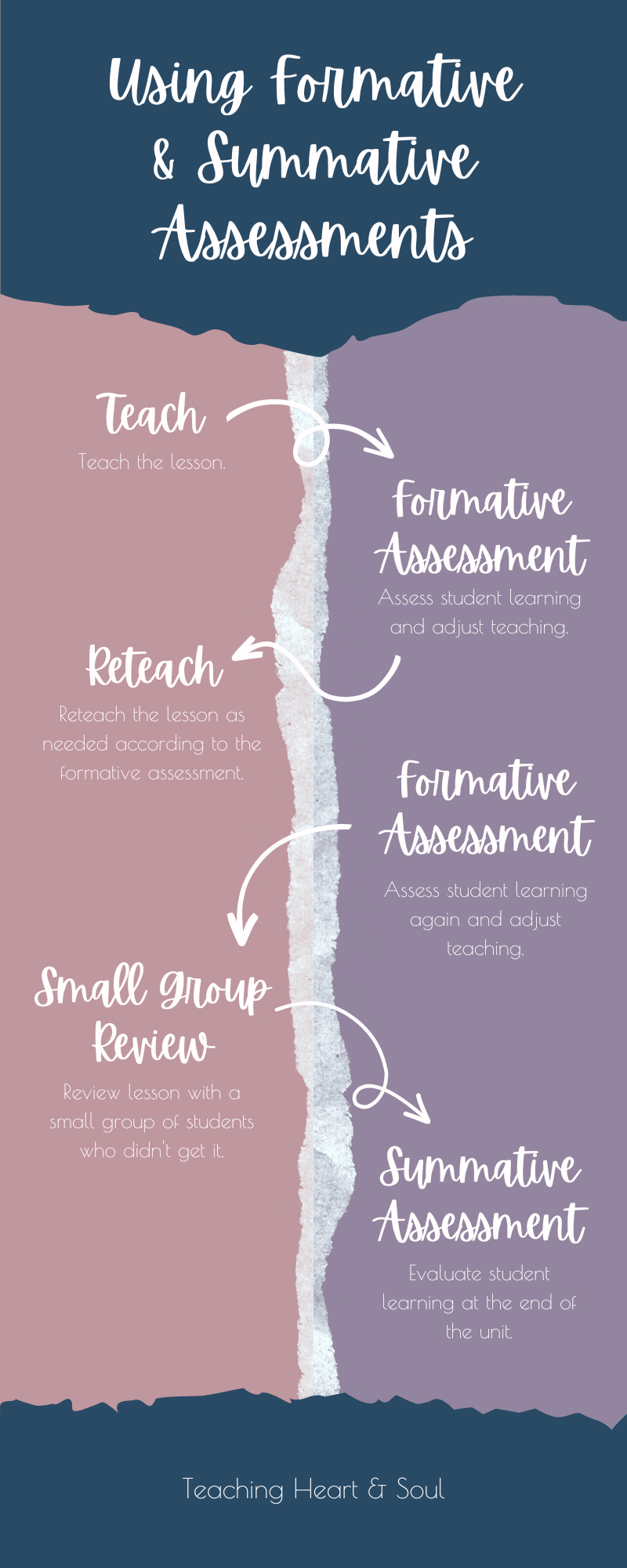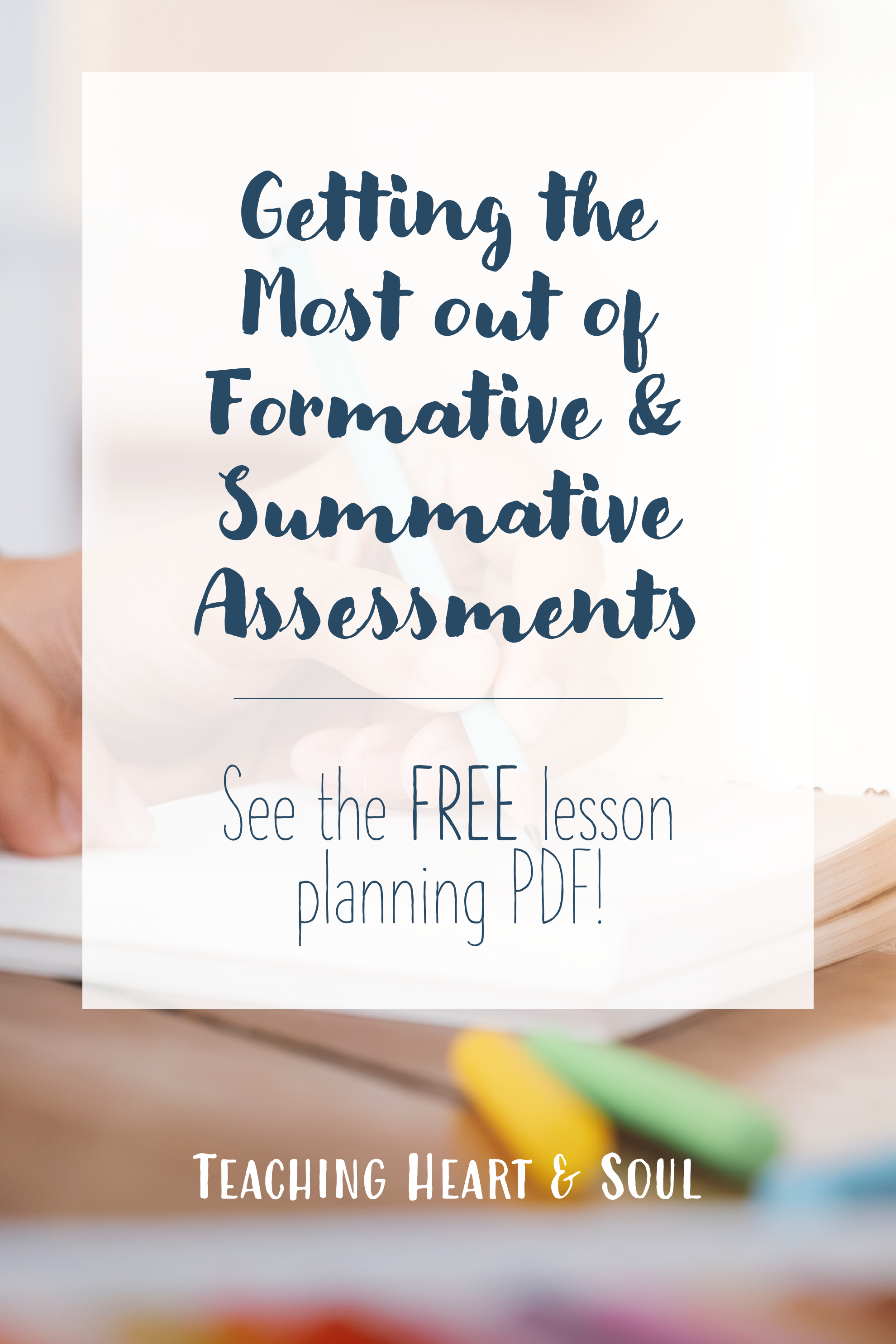Summative vs. Formative Assessment
When I first heard the terms "summative assessment" and "formative assessment" I was confused. With a little research, I learned the differences between these tools and realized I was already using both tools all the time in my classroom!
Formative assessments monitor a student's understanding throughout the instructional process, while a summative assessment measures student understanding at the end of a unit or course.
Formative assessment focuses on providing continuing feedback to improve student learning. A formative assessment refers to quizzes, questioning, and observation. These formative assessments act as an essential tool to monitor learning and adjust teaching strategies accordingly, ensuring that students are progressing in their learning.
On the other hand, summative assessment refers to the evaluation of a student's learning at the end of a unit or course. Common summative assessments include chapter tests and final exams.
While both are important, they serve different purposes. Formative assessments provide actionable feedback, while summative assessments measure student understanding at the end of a unit or course.
By using both formative and summative assessment strategies, educators can gather qualitative and quantitative data to evaluate learning and monitor student progress.
Formative vs. Summative Race Analogy
Formative and summative assessments can be compared to running a race.
Formative assessments are like checkpoints throughout the race, allowing the runner to monitor their progress, adjust their pace and strategy, and make necessary improvements. These checkpoints provide feedback and help the runner stay on track towards the finish line. Similarly, formative assessments provide feedback to educators and students about learning progress and help them adjust as needed.
On the other hand, summative assessments are like the finish line of the race, representing the final outcome and measuring the overall performance. Just like the runner's final time measures their performance in the race, the summative assessment measures the overall understanding and mastery of the subject or set of skills.
Formative Assessments
Definition & Purpose of a Formative Assessment
Formative assessments are an essential part of the learning process in elementary school.
The purpose of formative assessments is to check in throughout the learning process, providing feedback to help students improve. It also helps educators adjust their lesson plans to better meet the needs of the students.
Types of Formative Assessments
There are several types of formative assessments that teachers can use in the classroom.
One type is observation, where the teacher observes the student's behavior and interactions with others in the classroom.
Another type is questioning, where the teacher asks students questions to check their understanding of the material.
Quizzes are also a common form of formative assessment, allowing teachers to evaluate student learning and identify areas where students may need additional support.
By using a variety of formative assessments, teachers can gather a comprehensive understanding of their student's learning and adjust their teaching methods accordingly.
Formative Assessment Examples:
worksheets
exit tickets
classroom discussions
graphic organizers
paragraph writing
rough draft
homework
observations
quizzes
class presentations
surveys
group presentations
in-class games
How Is a Formative Assessment Used?
Teachers may use formative assessments to identify students who are struggling with a particular concept or skill and provide them with additional support. Teachers may also use formative assessments to track student progress over time and adjust their teaching methods to meet the individual needs of each student.
By providing ongoing feedback, formative assessments help students to stay engaged and motivated throughout the learning process.
Benefits of Formative Assessments
There are several benefits of formative assessments for both students and teachers.
For students, formative assessments provide feedback that can help them to identify areas where they need additional support and improve their learning. By receiving ongoing feedback, students can take ownership of their learning experience and own progress and feel empowered to achieve their learning objectives.
For teachers, formative assessments help to identify learning gaps and adjust their teaching methods accordingly. By providing teachers with a comprehensive understanding of their students' learning, formative assessments allow teachers to tailor their instruction to meet the needs of each student, promoting student success.
Want a FREE pdf with an overview of these assessment types, 21 lesson hook ideas, 41 differentiation strategies, and posters and exit tickets for active learning? Click here.
Looking for an editable lesson plan template with an editable scope & sequence and an editable rubric? Click here.
Summative Assessments
Definition & Purpose of a Summative Assessment
Summative assessments are another important part of the assessment process in elementary school. The purpose of summative assessments is to evaluate student learning at the end of an instructional unit or an entire course.
The goal of summative assessments and the grades attached to them is to measure student understanding of the material and provide a final evaluation of student achievement.
Types of Summative Assessments
There are many different forms and types of summative assessments that teachers can use in the classroom.
One type is high-point tests, where students are evaluated on their knowledge of the material through a series of questions or tasks.
Another type is exams, which are typically given at the end of a course or a semester and cover a range of topics.
Projects are also a common form of summative assessment, where students are given an opportunity to demonstrate their knowledge and understanding of the material through a creative project.
Summative Assessment Examples:
end-of-unit tests
mid-terms
standardized tests
final essays
high-point value quizzes
state tests
final projects
high-stakes tests
evaluations
district benchmarks
standards-based tests
demonstrations
final performances
chapter tests
final exams
How Is a Summative Assessment Used?
In the classroom, summative assessments are used to evaluate student progress and measure student understanding of the material. By providing a final evaluation of student achievement, summative assessments help teachers to identify areas where students may need additional support or instruction during the next course. Teachers can use the results of summative assessments to adjust their instructional methods and help students achieve their learning objectives.
Benefits of Summative Assessments
There are several benefits of summative assessments for both students and teachers.
For students, summative assessments provide a final evaluation of their achievement and help them to identify areas where they may need additional support or instruction. By measuring student understanding of the material, summative assessments help students to take ownership of their own learning and progress.
For teachers, summative assessments provide a way to evaluate the effectiveness of their instructional methods and adjust their teaching strategies as needed. By measuring student progress over time, summative assessments help teachers to tailor their instruction to meet the individual needs of each student, promoting student success.
Differences Between Summative and Formative Assessments
Timing & Frequency
One of the main differences is their timing and frequency.
Formative assessments occur during the learning process, while a summative assessment is conducted after learning has occurred - at the end of a unit or course.
Formative assessments are given frequently: weekly or even daily. Summative assessments, on the other hand, typically have a higher point value and are administered less frequently.
Purpose & Goals
Another difference is the purpose and goal.
The purpose of formative assessments is to monitor learning and provide immediate feedback to help students improve their understanding of the material. The goal of formative assessments is to help students develop their skills and knowledge over time.
Summative assessments, on the other hand, are used to evaluate learning. The main point of summative assessments is to measure achievement and determine whether students have met the objectives.
Grading
A formative assessment can typically be retaken or redone after further learning has occurred and can track students' progress. Sometimes, a formative assessment won't even be graded because it is used for formative purposes - to help the teacher adjust future lessons.
A summative assessment is not allowed to be retaken. It is a snapshot in time. Any growth may be shown on the next summative assessment, but once a test has been taken, the grade cannot change. A summative assessment or evaluation is always graded because it assesses achievement, rather than providing actionable feedback.
Focus & Scope
The focus and scope are also different.
Formative assessments focus on the process of learning, such as how students take in new information, make connections with prior knowledge and develop skills and understanding. This includes specific aspects of the teaching and learning process, such as student understanding of a particular concept or skill.
Summative assessments, on the other hand, focus on the product of learning and whether or not students are able to demonstrate competency based on a standard criteria.
Use of Data
Finally, the data is used differently.
Formative assessment results are used to provide ongoing feedback and adjust instruction to meet the needs of individual students.
The results of summative assessments and grades are used to assess the effectiveness of instruction and measure a student's performance.
While both types of assessments are important, the results of formative assessments are more immediate and actionable, while the results of summative assessments are more final and provide a big picture view of achievement.
Click here for a FREE resource listing summative & formative assessment examples, 21 lesson hooks, 41 differentiation strategies, and 10 posters and exit tickets for active learning!
Click here for an editable lesson plan, scope & sequence, and rubric.
Choosing an Assessment Type
Factors
When deciding between formative and summative assessments, there are several factors to consider.
These factors include the learning objectives of the unit, the goals of the final assessment itself, and the level of detail needed to evaluate student progress.
For example, formative assessments are best suited for evaluating student learning and providing ongoing feedback during the instructional process. On the other hand, summative assessments are ideal for measuring student achievement at the end of a unit or course.
Examples
There are many instances when formative assessments are the preferred assessment type. For example, when introducing a new concept, formative assessments can help teachers gauge student understanding and adjust their instruction accordingly.
Additionally, formative assessments are useful when teaching skills that require practice and repetition, as they allow teachers to monitor student learning progress and provide ongoing feedback.
On the other hand, summative assessments are more appropriate when evaluating student learning at the end of an instructional unit or course, as they measure student achievement against learning objectives.
Implementing Assessments into Your Lesson Planning
To help you implement a few ideas from this blog into your own classroom, I have created a free resource with some of this information in chart form, as well as a list of 21 lesson hooks, 41 differentiation strategies, and 10 posters and exit tickets for active learning.
I also have a resource that can help you take your lesson planning to the next level! This resource includes lesson plan templates, scope & sequence templates, and rubric templates, which are all completely editable!
If you’d like more information about other aspects of lesson planning, check out my other blogs.
What are you waiting for? Let me do the prep work so you can get back to the heart and soul of teaching!





